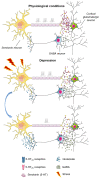The Implication of 5-HT Receptor Family Members in Aggression, Depression and Suicide: Similarity and Difference
- PMID: 35955946
- PMCID: PMC9369404
- DOI: 10.3390/ijms23158814
The Implication of 5-HT Receptor Family Members in Aggression, Depression and Suicide: Similarity and Difference
Abstract
Being different multifactorial forms of psychopathology, aggression, depression and suicidal behavior, which is considered to be violent aggression directed against the self, have principal neurobiological links: preclinical and clinical evidence associates depression, aggression and suicidal behavior with dysregulation in central serotonergic (5-HT) neurotransmission. The implication of different types of 5-HT receptors in the genetic and epigenetic mechanisms of aggression, depression and suicidality has been well recognized. In this review, we consider and compare the orchestra of 5-HT receptors involved in these severe psychopathologies. Specifically, it concentrates on the role of 5-HT1A, 5-HT1B, 5-HT2A, 5-HT2B, 5-HT2C, 5-HT3 and 5-HT7 receptors in the mechanisms underlying the predisposition to aggression, depression and suicidal behavior. The review provides converging lines of evidence that: (1) depression-related 5-HT receptors include those receptors with pro-depressive properties (5-HT2A, 5-HT3 and 5-HT7) as well as those providing an antidepressant effect (5-HT1A, 5-HT1B, 5-HT2C subtypes). (2) Aggression-related 5-HT receptors are identical to depression-related 5-HT receptors with the exception of 5-HT7 receptors. Activation of 5-HT1A, 5-HT1B, 5-HT2A, 5-HT2C receptors attenuate aggressiveness, whereas agonists of 5-HT3 intensify aggressive behavior.
Keywords: aggression; behavior; brain serotonin system; depression; serotonin receptors; suicide.
Conflict of interest statement
The authors declare no conflict of interest.
Figures



Similar articles
-
Phosphoinositide system-linked serotonin receptor subtypes and their pharmacological properties and clinical correlates.J Psychiatry Neurosci. 1995 May;20(3):215-25. J Psychiatry Neurosci. 1995. PMID: 7786883 Free PMC article. Review.
-
5-HT1A receptor as a key player in the brain 5-HT system.Rev Neurosci. 2013;24(2):191-204. doi: 10.1515/revneuro-2012-0082. Rev Neurosci. 2013. PMID: 23492554 Review.
-
Studies on the neuroendocrine role of serotonin.Dan Med Bull. 2007 Nov;54(4):266-88. Dan Med Bull. 2007. PMID: 18208678 Review.
-
[The pharmacological basis of the serotonin system: Application to antidepressant response].Encephale. 2016 Jun;42(3):255-63. doi: 10.1016/j.encep.2016.03.012. Epub 2016 Apr 23. Encephale. 2016. PMID: 27112704 Review. French.
-
[Polymorphism in 5-HT receptors as the background of serotonin functional diversity].Ross Fiziol Zh Im I M Sechenova. 2010 Aug;96(8):778-86. Ross Fiziol Zh Im I M Sechenova. 2010. PMID: 20968063 Review. Russian.
Cited by
-
Unveiling GABA and Serotonin Interactions During Neurodevelopment to Re-Open Adult Critical Periods for Neuropsychiatric Disorders.Int J Mol Sci. 2025 Jun 9;26(12):5508. doi: 10.3390/ijms26125508. Int J Mol Sci. 2025. PMID: 40564972 Free PMC article. Review.
-
Chain mediation of anxiety and suicidal ideation: a 2021-2025 cross-sectional analysis in Chinese temporomandibular disorders patients.BMC Psychiatry. 2025 Jul 7;25(1):681. doi: 10.1186/s12888-025-07020-x. BMC Psychiatry. 2025. PMID: 40624464 Free PMC article.
-
Multiple modulatory roles of serotonin in chronic pain and injury-related anxiety.Front Synaptic Neurosci. 2023 Apr 18;15:1122381. doi: 10.3389/fnsyn.2023.1122381. eCollection 2023. Front Synaptic Neurosci. 2023. PMID: 37143481 Free PMC article. Review.
-
Exploring the influence of stress on aggressive behavior and sexual function: Role of neuromodulator pathways and epigenetics.Heliyon. 2024 Mar 3;10(5):e27501. doi: 10.1016/j.heliyon.2024.e27501. eCollection 2024 Mar 15. Heliyon. 2024. PMID: 38486749 Free PMC article. Review.
-
Prevalence and correlates of severe anxiety in patients with first hospitalization for major depressive disorder combined with dyslipidemia: a large sample cross-sectional study.Front Psychiatry. 2024 Jan 17;14:1289614. doi: 10.3389/fpsyt.2023.1289614. eCollection 2023. Front Psychiatry. 2024. PMID: 38298928 Free PMC article.
References
-
- Linnoila V.M., Virkkunen M. Aggression, suicidality, and serotonin. J. Clin. Psychiatry. 1992;53:46–51. - PubMed
Publication types
MeSH terms
Substances
Grants and funding
LinkOut - more resources
Full Text Sources
Medical

